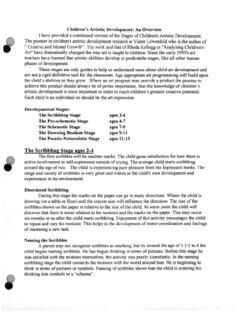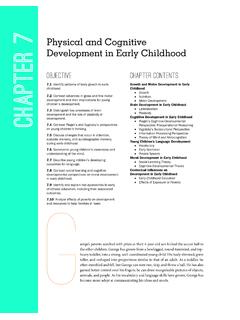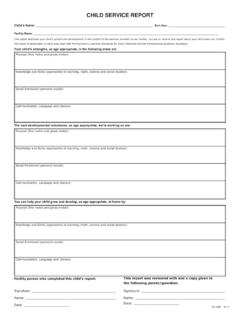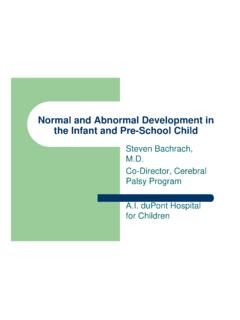Transcription of Children's Artistic Development: An Overview I have ...
1 Children's Artistic development : An OverviewI have provided a condensed version of the Stages of Children's Artistic pioneer in Children's Artistic development research is Viktor Lowenfeld who is the author of" Creative and Mental Growth". His work and that of Rhoda Kellogg in "Analyzing Children'sArt" have dramatically changed the way art is taught to children. Since the early 1950's artteachers have learned that Artistic abilities develop in predictable stages, like all other humanphases of stages are only guides to help us understand more about child art development andare not a rigid definitive tool for the classroom.
2 Age appropriate art programming will build uponthe child's abilities as they grow. Where an art program may provide a product the process toachieve this product should always be of prime importance, thus the knowledge of children'sartistic development is most important in order to reach Children's greatest creative child is an individual so should be the art Stages:The Scribbling Stage ages 2-4 The Pre-schematic Stage ages 4-7 The Schematic Stage ages 7-9 The Dawning Realism Stage ages 9-11 The Pseudo-Naturalistic Stage ages 11-13 The Scribbling Stage ages 2-4 The first scribbles will be random marks.
3 The child gains satisfaction for here there isactive involvement in self-expression outside of crying. The average child starts scribblingaround the age of two. The child is experiencing pure pleasure from the haphazard marks. Therange and variety of scribbles is very great and relates to the child's own development andexperiences in his ScribblingDuring this stage the marks on the paper can go in many directions. Where the child isdrawing (on a table or floor) and the crayon size will influence the direction. The size of thescribbles shown on the paper is relative to the size of the child.
4 At some point the child willdiscover that there is some relation to his motions and the marks on the paper. This may occursix months or so after the child starts scribbling. Enjoyment of this activity encourages the childto repeat and vary his motions. This helps in the development of motor coordination and feelingsof mastering a new the ScribblesA parent may not recognize scribbles as anything, but by around the age of 3 1/2 to 4 thechild begins naming scribbles. He has begun thinking in terms of pictures. Before this stage hewas satisfied with the motions themselves, the activity was purely kinesthetic.
5 In the namingscribbling stage the child connects the motions with the world around him. He is beginning tothink in terms of pictures or symbols. Naming of scribbles shows that the child is ordering histhinking into symbols or a "schema".MotivationAt no point should a child be inhibited, criticized or corrected while creating art duringany stage of his development . Usually in the first stages of scribbling no special motivation isneeded except to provide the child with the proper materials and the encouragement to go aheadwith the child's own experiences are fertile topics that can motivate and excite them in artactivities.
6 Class field trips, stories from books, personal experiences etc. should be discussedbefore an art lesson to help the child to draw from his own vision, and thus enjoy and learnduring the art MaterialsThe best materials for this stage are simple and easy to manipulate, fat black crayons ormarkers, 11 "x 18" (or smaller) white paper, white chalk on black paper or a chalkboard. I do notrecommend the use of finger paints for children of any age. Children do not learn to use tools, inthis case a paintbrush, nor does finger paint encourages the manipulation of paint.
7 The fingerpaint distracts the children from the painting process, while they soil everything within theirreach, the painting activity is should be thick tempera or poster paints with large white paper and round mediumsized brushes. Play dough, or easy to form modeling clay are wonderful in the development offine and gross motor coordination. Occasional use of collage materials from random shapes(NOT PRECUT SHAPES) can add fun and involvement in cutting and pasting. Stencils can beuseful if limited to the child manipulating and learning how to use the the children to cut their own shapes using safety scissors.
8 They will derive pureenjoyment from this activity and show great pride in their achievement. Cutting with scissors caninvolve a child completely in his discovery in the use of a tool. A child's fine motor coordinationcan develop rapidly through the mastery of cutting paper. Some children will not possess thegross motor coordination to even hold a pair of scissors, however tearing paper into shapes canfulfill the child's need to manipulate paper into shapes of his own Representational Attempts: The Pre-schematic Stage 4-7 yearsA different mode of drawing has begun- the conscious creation of form.
9 From thedisordered scribbling, to naming the scribbles now the child has developed a way to representform. In scribbling the child was mainly interested in kinesthetic activity, now he is involved inrepresenting the world around child's first representational attempts grow directly from symbols the child was usingduring the scribbling stage. The circles and longitudinal lines will come together to form aperson. Usually the child's first representational symbol is a man. The man is typically drawnwith a circle for a head and two vertical lines as arms legs or a body.
10 At this stage a child isconstantly searching for new concepts, so while the "man" is always of primary importance it'sform may change many constant searching for new concepts will continue until about age 7. By this time theindividual pattern or "schema" will begin to appear. The child is involved in discovering his ownpatterns, which will at times translate into direct and immediate representations of places andevents. A child's feelings can have profound effect upon his art creation. The more stimulating achild's experiences the more dramatic and exciting his artwork will be.





